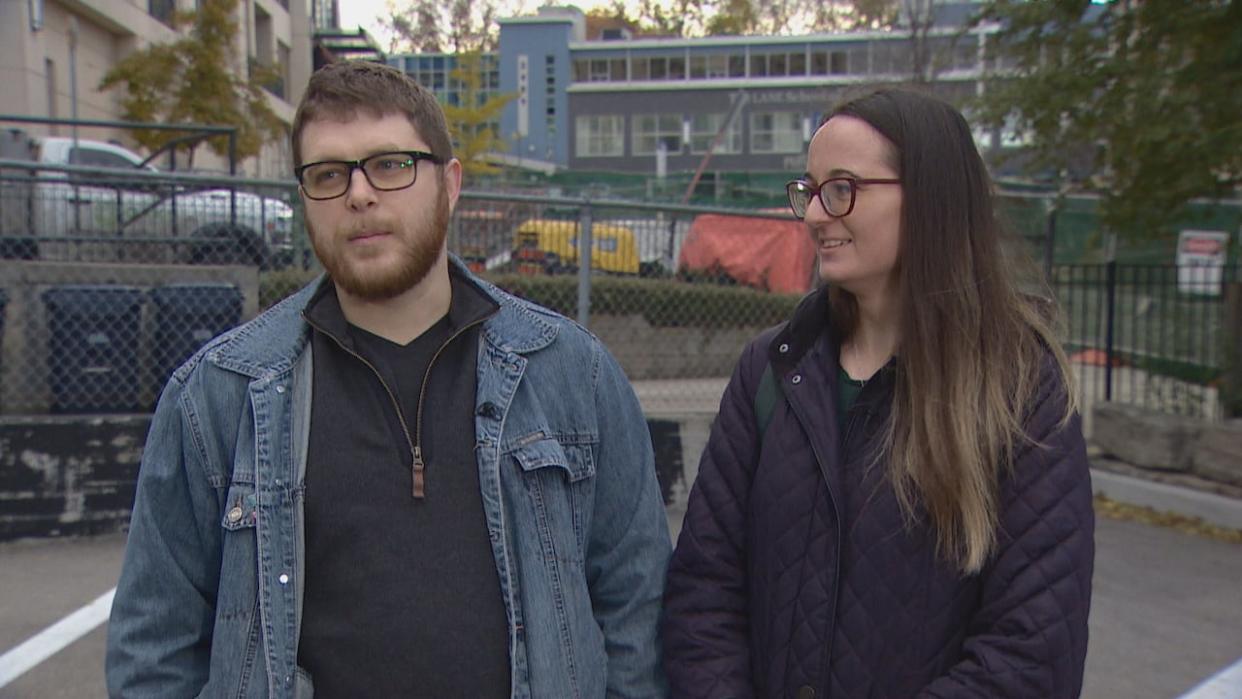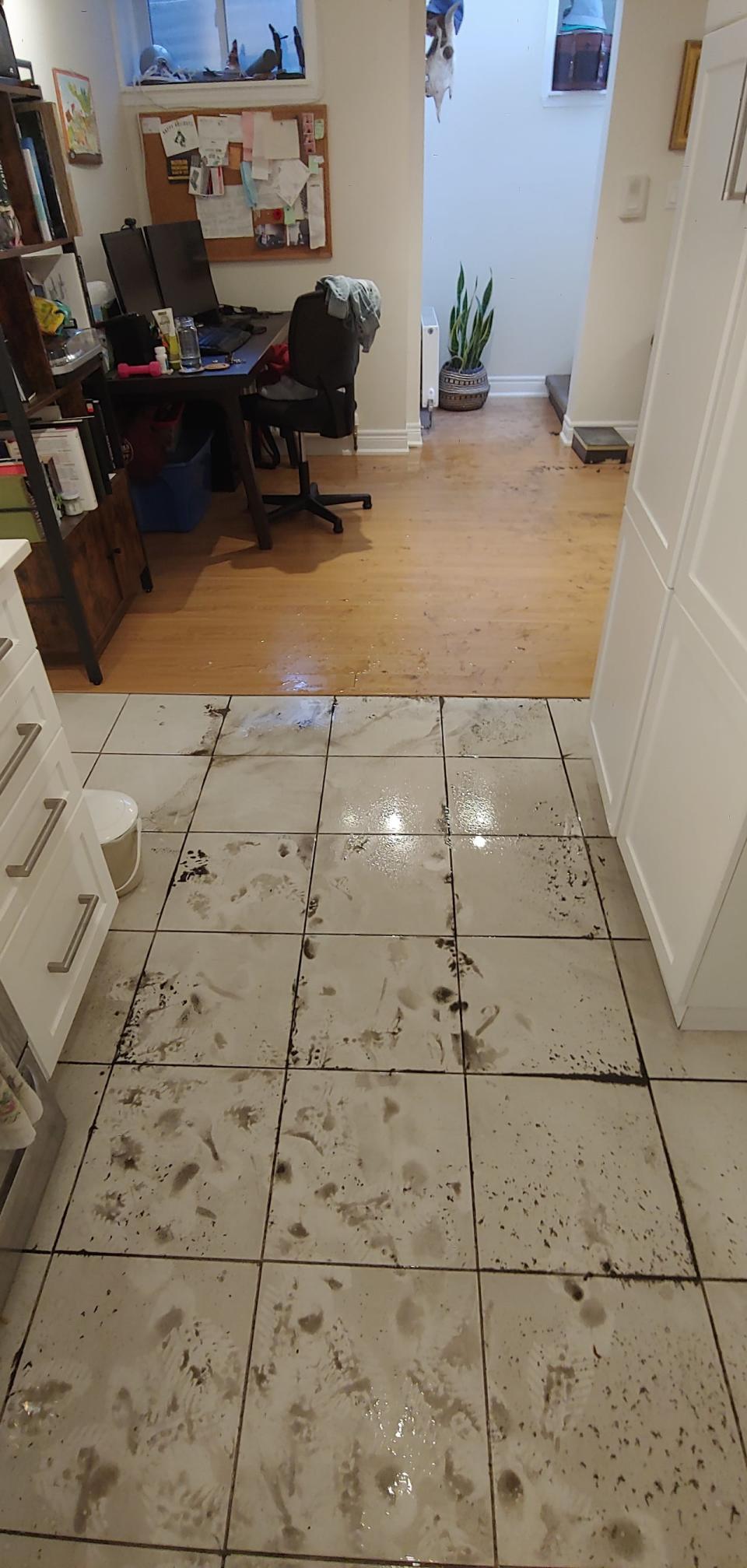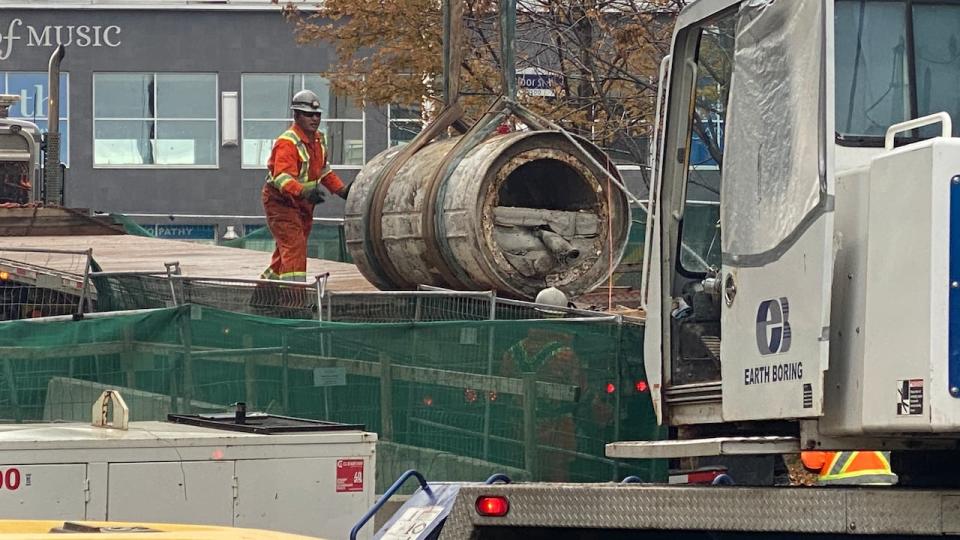Toronto couple blames stuck boring machine for flooding their apartment with sewage

Kyle Gibbons can still remember his panic as he saw water pouring from a pipe near the door of his basement apartment in Bloor West Village.
On May 10, Gibbons says his landlord called him to say there had been a flood, and he raced home from work to find a sump pump forcing a "vast amount" of water from his place.
"The water was flowing through like a river from one end of the apartment all the way to the other end," he told CBC Toronto.
Frantic to save what he and his wife owned, he grabbed what he could and dragged it upstairs.
At first, the liquid seemed clear. But after a second flood a day later, Gibbons says the terrible smell indicated he was scrambling around in a mix of water and sewage.
He says the city of Toronto is to blame for the flooding. Both Gibbons and his landlord, Greg Tershakowec, believe the problem was caused by work taking place some 10 metres from the home to rescue a multi-million dollar micro-tunnel boring machine, which made headlines for months as contractors tried to free it.
In the spring, they say the work to free the machine cracked a pipe, causing the flood. Contractors were using grout to stabilize the ground around the machine, Gibbons and the landlord allege the material cracked a ceramic sewage pipe, resulting in flooding.
"As the investigation proceeded, it became evident that the grout had entered the main sanitary line causing the blockage," Tershakowec wrote in a letter to the couple.
The machine was freed on Oct. 11. But Gibbons and his wife, Hannah Spasov, have been left frustrated with the city. They say the project never should have gotten so out of control and they're now speaking up about their experience as a result.
"This is unacceptable for the city to take this long," Spasov said. "It's unprofessional. It's disrespectful to the people who live here."
Gibbons says the flooding destroyed some $30,000 worth of the couple's belongings, including irreplaceable items like hand-crafted furniture, high school year books and family mementos.

Water and sewage sit on the floor of Kyle Gibbons and Hannah Spasov's apartment on Old Mill Drive after a second flood in May. The couple allege work to rescue a boring machine trapped 10 metres from the home caused the flooding. (Submitted by Hannah Spasov )
Work to free boring machine took 19 months
The troubled project on Old Mill Drive began in March 2022 to help alleviate chronic basement flooding in the area. City staff opted to use a remote controlled micro-tunnelling boring machine, 1.5 metres wide and five metres long, to create a new sewer tunnel.
The plan was for the machine to be placed 18 metres below ground and have it travel 282 metres to a pre-constructed exit shaft on Bloor Street West. But with just seven metres left to go on its route, the machine hit and became ensnared in 14 underground steel tiebacks that had been part of the construction of a nearby condo building.
It took 19 months to free the machine, but problems continue to plague the project today.
A few weeks ago, sewage backed up a number of times and overflowed from sanitary sewers, running down Old Mill Drive.
Last week neighbours were told by the city that work to complete the project has been "paused".
"The basement flooding protection program on Old Mill Drive has been paused while the city and the contractor that it's hired can review the terms of that contract and really start to establish what steps need to happen at this point," city spokesperson Russell Baker told CBC Toronto.
Baker would not confirm or deny if city was responsible for the flooding Gibbons and Spasov's apartment.
He said the city is aware of sewer blockages in the area and is working to address them.
"We've brought in an outside contractor right now to conduct the clearing of debris and grout that was originally used to fill crevices and gaps or voids, due to the size of the blockages that are in the sewers," he said.
The city had pegged the cost of the work at $25 million and estimated it would be completed by December, with some additional restoration work taking place in the spring. It's not clear how this latest delay will impact those costs and that timeline.
Detailed look at what went wrong needed: expert
Matti Siemiatycki, the director of the Infrastructure Institute at the University of Toronto, said using boring machines is risky and relies on the accuracy of records used to track underground utilities.
When these projects go wrong, they can deeply impact communities, he added.
"[Neighbours] weren't expecting this and now the impacts have just really seemed to be disastrous for them," he said.
Siemiatycki said the city needs to conduct an in-depth post-mortem on everything that's gone wrong on the project.
"We need to be pretty intentional so that we don't keep making the same mistakes over and over again," he said.

The rear section of a micro tunnel boring machine that was trapped underground in west Toronto since spring 2022 is seen lifted onto a flatbed truck after being freed. (Paul Smith/CBC)
Meanwhile, Gibbons and Spasov say the flooding left them living in an Airbnb until September.
They say they continued paying for their Old Mill Drive rental over the summer, hoping the apartment would be restored. But with the work held up, emergency funds from their insurer were running out and they were forced to abandon their place.
"It's unfortunate because we didn't want to move," Spasov said. "We'd been there for about six years. We built our life there."
Months later, they say they still haven't been paid out for their belongings.
Aviva Canada, their insurer, apologized to the couple for the delay.
"[We] are working with them to settle the claim as quickly as we can," spokesperson Hazel Tan said in a statement.
While the couple is in a new place now, Gibbons said they watch the continuing developments on the project with a sense of disillusionment.
"You kind of don't expect the next disaster to happen. And then there it is," he said.


